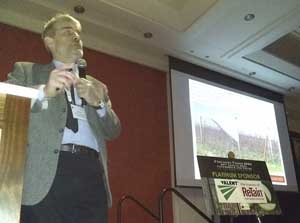The first day of “Precision Vision 2020,” the 63rd annual conference of the International Fruit Tree Association, is a wrap. Held in Grand Rapids, Michigan, the first day of the conference focused on precision canopy and orchard management.
Here are a few snippets from the presentations:
The first speaker, Luca Corelli-Grappadelli, a physiologist at the University of Bologna, led off with a talk about the challenges facing Italian fruit growers. Those challenges include high labor, energy and transport costs; the loss of international markets (namely Russia) and lack of new markets to replace them; the loss of chemicals (due to strict European Union policies); and new and more difficult pests (the brown marmorated stink bug did more than half a billion euros’ worth of damage in the Emilia-Romagna growing region in 2019 alone).

Italian fruit farms tend to be small but intensive, with a strong emphasis on new varieties and early bearing. Growers there are abandoning low-density systems in favor of hedgerow systems, with pruning strategies geared to vigor control, high quality and high yields. They’re also seeking to simplify the tree structure.
“Trees are getting simpler and simpler and simpler,” he said. “We’re moving away from orchard designs that cannot be coupled to mechanization.”
Replant diseases are common in Italy. Solutions vary — from choice of rootstock, to changing the soil in the row (especially in apple), to a more radical “soil exchange” in peach country, Corelli-Grappadelli said.
Michigan State University’s Greg Lang discussed the unique challenges of training sweet cherry trees — challenges that originate with the tree’s physiology. Following its natural growth habit, an apple tree can grow to about 40 feet, a pear tree to about 65 feet. A cherry tree, on the other hand, can grow to 135 feet in its natural habitat.
“It’s a forest tree,” Lang said. “It evolved over centuries to survive in forests.”
Historically, grower training techniques have focused on trying to manage that incredible vigor, rather than managing crop load.
“(The cherry tree) still thinks it’s in the forest and trying to grow up and capture light,” Lang said. “That’s what we’re trying to manage.”
Modern cherry training is moving toward planar systems. Lang focused especially on the UFO system — Upright Fruiting Offshoots — named by Washington State University’s Matthew Whiting.
Lang expects UFO systems to be more common a decade from now. The system utilizes the natural growth habit the cherry tree has evolved over the centuries, its yields are equal to or greater than other systems, fruit quality and crop load management are more uniform, hand harvest is more efficient and UFO is more adaptable to the use of precision tools.
Justin Finkler, operations manager at Riveridge Produce Marketing, discussed his company’s efforts using precision orchard training systems. Several years ago, Riveridge was looking for higher-yielding apple systems — systems that also would be a good match for self-propelled platforms and would “allow us to compete with the most advanced growers in the business,” he said.
They decided to try a V system. Their first V-trellis planting was in 2014, Royal Red Honeycrisp on Nic.29 rootstock on a 12-foot by 2-foot spacing. Over the next few years, they improved the trellis system — more stakes in the ground, a steepened angle, stronger bracing, tighter wires, better anchors, sleeping eyes — and by 2018 they were planting more trees per acre, he said.
Riveridge has planted about 260 acres of apples on V-trellis since 2014, along with 20 acres of sweet cherries, and plans to continue with that system, in the belief it can hit their yield and quality goals, Finkler said.
—by Matt Milkovich
Related:
—IFTA Day 2: Innovation in the cold
—IFTA Day 3: Precise crop management
—IFTA Day 4: Innovation in the even colder






Leave A Comment